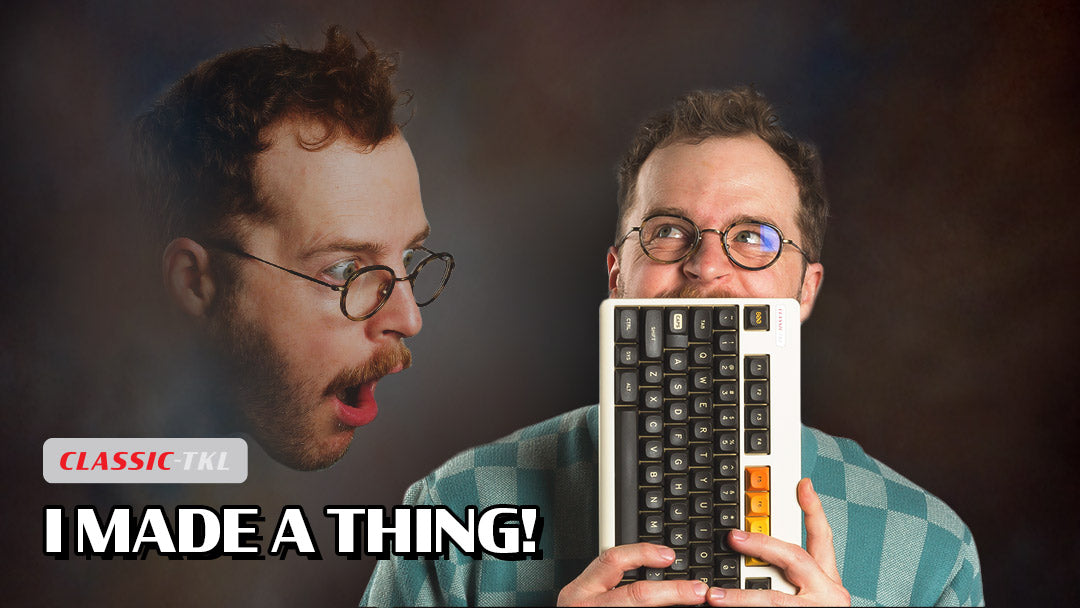
Hello reader, and welcome to the NK newsroom series where we interview makers and creators about exciting new products. I’m your writer Riley, and today I’m sitting down with Nephlock who designed the upcoming CLASSIC-TKL keyboard to ask him all about it.
Where did your inspiration for the classic come from? Why a TKL?
When I set out to design the CLASSIC-TKL (before it was even called that), I had a few objectives that I wanted it to hit. I wanted it to serve as a good point of entry into the hobby for those just arriving, it had to still appeal to the current enthusiast market, and I wanted it to have a retro aesthetic. Thinking about those objectives is what led me to the TKL layout. It’s the closest standard to what people are used to, while also resonates strongly with current enthusiasts—and has strong representation throughout the history of mechanical keyboards.
Setting to brainstorming, I landed on this idea of an homage to (what I consider) some of the formative TKL boards of the hobby—A board that assembles some punch-list elements of features and styling and blends them into its own thing. It's a hard thing to edit yourself and choose a good amount of features without overkill. There are boards that have a lot of character and become love it or hate it—I wanted this one to have just enough character to be memorable and unique, but not so much that it stumbled for lack of direction.
Once I had everything feeling great and just the right amount, the Classic was born. You’ll see some similarities to boards like the Realforce R1, Matrix 1.2, Keycult No.1, and with packaging pulling from the IBM Model F. It still wasn't called the Classic, but the name quickly fell into place when i had to describe it. What is it?... "well, it's a classic tkl!"

Why did you choose injection molding?
The primary decision on this was price point. In order to serve as an entry point it needs to be approachable for the customer financially. NovelKeys plans to have this board around for a while so investing in the up front cost of injection tooling made sense in order to offer it at the price point we targeted. I also believe there’s a lot of unexplored runway left in the world of injection keyboards. It’s a realm we as a community have left largely unexplored.
The giant silicone foot. Where did that come from?
Ironically of all places... My camping french press. It has this whole bottom that is rubberized so it doesn't slide around. Why not do that for keyboards? It's basically what we already do with small keyboard feet as a method to isolate it from the table surface. With aluminum boards the bottom is typically some weight or other accented metal, but with an injection boards those features can become problematic. This felt like the perfect way to give the bottom texture, grip, and a large area for accent color.
What is your personal configuration for the CLASSIC-TKL?
Silicone bottom, no foams, polycarbonate plate (default). A lot of options for configuration are available, but I wanted the default version to contain what I felt to be the best one.

Can I control each LED individually?
In short? No*. The Classic uses VIA to configure, and is set up to do all of the LEDs as a whole unit, rather than individually. Even the lightbar is set up to fall in line with the full board LED pattern. *The longer answer is that the board is rooted in QMK, so those of you with some very adept tinker knowledge can manually adjust to your hearts content.
Does it support any aftermarket PCBs?
Both the main PCB and the daughter PCB are proprietary to the CLASSIC-TKL. The main board requires some edge cuts to avoid mounting posts, and contains the LEDs for the lightbar to function. Similarly, while we tried to implement with the Unified Daughterboard Project, the daughter board needed to be a very specific size in order to work with the geometry of the enclosure.
Do you plan on expanding the line to other layouts?
I’d love to. Like I mentioned, I think doing the TKL first was the right choice given the objectives, but I’d love to see the design language of the Classic extend into additional layouts and sizes. A 60% could be really fun here.
What are the future plans for the CLASSIC-TKL?
OOF. YES! And yes! I would love to see this thing take off, and a lot of those future plans need to be paired with the demand for them. The good news is that we’ve already heard some requests and answered! Initial teases of the board were met with some questions regarding ISO support, and we’re currently working on an ISO barebones version for those markets. We’ve also heard a large amount of people request for WKL, and I’m happy to say that we’ve already put in a mold order to be able to produce WKL tops as an add-on item.
We’ve also got some further plans in the works that I’ll keep close to the chest for the time being, but stay tuned ;).
